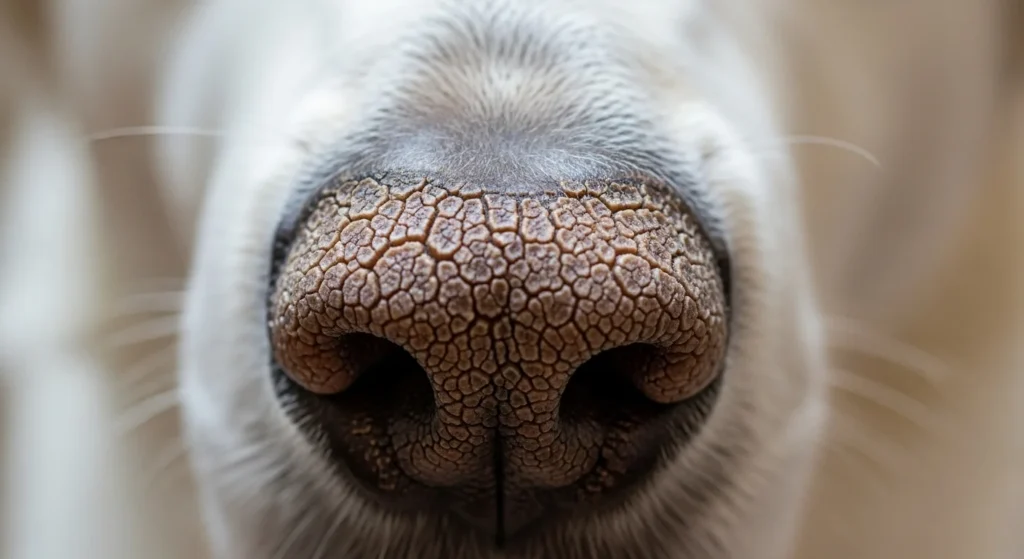
What is hyperkeratosis in dogs?
So, hyperkeratosis in dogs is basically when your pup’s skin decides to go a little rogue and starts producing too much keratin—the stuff that makes up hair, nails, and outer skin layers. The result? Thick, crusty, sometimes calloused patches. It’s not a disease by itself, but it’s usually a sign that something else might be going on. Think of it like your dog’s skin putting on armor… kind of overdoing it.
Which parts of a dog are most commonly affected (nose, paw pads, elbows)?
The usual trouble spots are the nose, paw pads, and elbows. The nose can get all crusty and cracked, paws might feel like little hairy pads, and elbows often develop rough calluses. Basically, anywhere that takes a lot of pressure or friction is fair game. These areas are like your dog’s “high traffic zones”—wear and tear shows up fast!
What are the typical signs and symptoms of hyperkeratosis?
You’re looking for thickened skin, rough or crusty textures, cracks, discoloration, or even flaky keratin debris. Sometimes it bleeds if the cracks are deep, and infections can pop up if things get nasty. Keep an eye out for changes in walking, limping, or signs that your dog is avoiding paw contact—these are subtle ways they tell you it hurts.
Is hyperkeratosis painful for dogs?
Yep, it can be. Mild cases might not bother your pup, but when cracks get deep or infections sneak in, it can really sting. Some dogs will limp, yelp, or act grumpy when you touch the affected areas. Basically, if your dog is suddenly walking on tiptoes like a tiny ballerina, it’s time to check those pads.
Causes and Risk Factors
What causes hyperkeratosis in dogs?
There’s a bunch of reasons. Genetics, chronic irritation, autoimmune stuff, distemper, zinc deficiency, infections—you name it. Sometimes it’s just your dog’s body reacting to an underlying issue. Basically, hyperkeratosis is like the skin screaming, “Hey, something’s off down here!”
What’s the difference between primary (hereditary) and secondary hyperkeratosis?
Primary hyperkeratosis is just the dog’s DNA doing its thing—born with it, stuck with it. Secondary hyperkeratosis shows up because of another problem, like a nutritional deficiency, infection, or chronic irritation. The good news? Secondary forms often get better if you fix the main problem.
Are certain breeds more prone to hyperkeratosis?
Yep. Breeds like Dogues de Bordeaux, Irish Terriers, and Kromfohrländers are more likely to get it. Even some short-nosed dogs seem to have extra crusty noses sometimes. So, if you have one of these breeds, it’s worth keeping an eye on their nose and paws.
Can puppies develop hyperkeratosis, or is it mainly seen in older dogs?
Both, actually! Puppies can get hereditary hyperkeratosis pretty young, showing mild nose or paw changes. Secondary forms usually pop up later when another condition starts affecting their skin. So even the cute little fuzzballs aren’t entirely off the hook.
Diagnosis and Related Conditions
How do veterinarians diagnose hyperkeratosis?
The vet will check your pup’s history and do a thorough look at the skin. They might do skin scrapings, cytology, fungal cultures, bloodwork, or even a biopsy to figure out what’s going on. Sometimes, genetic testing is used for breeds prone to hereditary forms. Experts like dermatologists at university vet hospitals are pros at spotting the subtle differences.
What other conditions can look similar to hyperkeratosis?
Some other things that can mimic hyperkeratosis include calluses, pemphigus, lupus, chronic pododermatitis, and infections. That’s why a proper vet check is crucial—no one wants to treat the wrong thing.
Is hyperkeratosis contagious to other pets or humans?
Good news: nope. Hyperkeratosis itself isn’t contagious. But if your dog has a secondary infection on top of it, that infection could potentially spread. So, always keep things clean and wash your hands after handling affected areas.
Treatment and Veterinary Care
How is hyperkeratosis treated by veterinarians?
Vets usually start by softening the thickened skin with lukewarm soaks, then gently trim or debride it. Topical creams, keratolytics, or emollients help the skin shed naturally. If there’s an infection, antibiotics or antifungals may come into play. And of course, they’ll treat any underlying issues to stop the cycle.
Are there medications for severe cases, and what are their possible side effects?
Sometimes oral retinoids or vitamin A derivatives are used, but these can be tricky—they might cause liver issues, dryness, or other side effects if not monitored closely. Dr. Lisa Kane, a veterinary dermatologist, notes that systemic treatments can work wonders but need careful supervision.
Can secondary hyperkeratosis improve if the underlying cause is treated?
Absolutely! Fix the root problem—like a zinc deficiency or chronic dermatitis—and you’ll often see the skin improve. Primary hereditary cases usually require ongoing care, but secondary forms can sometimes disappear altogether.
How long does it take for treatment or management to show improvement?
Patience is key. You might notice softening and less cracking in a few weeks, but full improvement can take months. Think of it like growing a garden—it doesn’t happen overnight.
How often should my dog see the vet for follow-up visits?
Initially, every 2–4 weeks until things start improving. Once stable, quarterly check-ups are usually enough. Severe or unpredictable cases may need monthly monitoring.
Home Management and Preventive Care
How can I care for my dog’s hyperkeratosis at home?
Daily soaks in lukewarm water or saline, followed by applying a good vet-approved balm, go a long way. Protect paws with soft booties on rough surfaces, keep skin clean, and even use a humidifier if the air’s dry. Consistency is your best friend here.
Can I safely trim or file the thickened skin myself?
You can, but carefully. Only after soaking, and make sure no bleeding or pain occurs. A fine emery board works for minor trimming. Otherwise, leave it to the pros—vets or groomers—so you don’t accidentally hurt your dog.
Can diet, omega-3s, or zinc supplements help prevent or manage hyperkeratosis?
Yes! A high-quality diet with essential fatty acids and zinc helps keep skin healthy. If your dog has a confirmed deficiency, supplements can really help. Just don’t go overboard—too much zinc can be toxic.
Can the condition lead to infections or other complications?
Definitely. Deep cracks can get infected, causing cellulitis, abscesses, or pain. Your dog may limp or avoid walking on affected paws, so keeping the skin protected is essential.
What steps can help prevent hyperkeratosis altogether?
Avoid rough surfaces, protect paws in extreme weather, feed a balanced diet, maintain hygiene, and manage any underlying skin conditions. Early monitoring in breeds prone to hereditary forms is smart too.
When should I seek urgent veterinary attention?
Red flags: deep bleeding cracks, swelling, pus, obvious pain, or no improvement after a week of home care. At that point, don’t wait—call the vet.
Prognosis and Long-Term Outlook
Is there a permanent cure for hereditary hyperkeratosis?
Unfortunately, no. You can’t completely cure it, but with consistent care, your dog can live comfortably. The goal is to keep the skin soft, prevent infections, and maintain quality of life.
Will hyperkeratosis affect my dog’s quality of life or life expectancy?
Life expectancy isn’t usually affected if there’s no underlying disease. Quality of life depends on how severe the cracks and pain are. Many dogs do just fine with proper care.
What are the expected costs for diagnosis and ongoing management?
Expect initial diagnostics to cost a few hundred dollars, with ongoing costs for creams, supplements, vet visits, and sometimes medications. Chronic cases have regular costs, but proper planning keeps it manageable.
Where can I find reliable photos or resources to help identify hyperkeratosis?
Check out PetMD, VIN (Veterinary Information Network), and university veterinary dermatology websites. Peer-reviewed journals like Veterinary Dermatology also have high-quality images and case studies.
please leave comment
sources
you may like it






